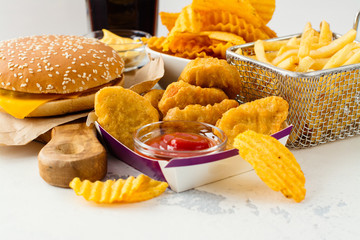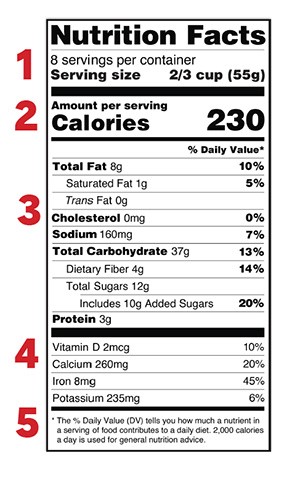
This week you will learn how to find the sodium hiding in your diet and begin tracking how much you consume. Tracking your sodium will give you a great foundation of knowledge for the rest of this Mini Challenge and will give you a baseline to work from when working to eat a healthier amount.
Where do we get most of our sodium?
Action Step:
Watch this video and take the short quiz afterwards.
In Day 1, you learned that most sodium Americans eat comes from processed, prepackaged and restaurant foods and not from the saltshaker. Learning how to read and understand food labels will help you track the amount of sodium in your diet.
Action Step:
Following these instructions, go through some of the prepackaged foods in your home or at the grocery store that you normally eat to see how much sodium they contain.
Understanding Food Nutrition Labels
Learning how to understand and use the Nutrition Facts label can help you make healthier eating choices and identify nutrient-dense foods for a healthy diet. Here are some tips from the American Heart Association for making the most of the information on food labels.

Learn what to look for on the label:
- Start with the serving information at the top.
This will tell you the size of a single serving and the total number of servings per container (package). - Next, check total calories per serving and container.
Pay attention to the calories per serving and how many calories you’re really consuming if you eat the whole package. If you double the servings you eat, you double the calories and nutrients.
The next section of information on a nutrition label is about the amounts of specific nutrients in the product. - Limit certain nutrients.
Check key nutrients and understand what you’re looking for. Not all fats are bad, and total sugars can include both natural and added sugars. Limit the amounts of added sugars, saturated fat and sodium you eat, and avoid trans fat. When choosing among different brands or similar products, compare labels and choose foods with less of these nutrients when possible. - Get enough of the beneficial nutrients.
Make sure you get enough of the nutrients your body needs, such as: calcium, choline, dietary fiber, iron, magnesium, potassium, and vitamins A, C, D and E.* - Understand % Daily Value.
The % Daily Value (DV) tells you the percentage of each nutrient in a single serving, in terms of the daily recommended amount. If you want to consume less of a nutrient (such as saturated fat or sodium), choose foods with a lower % DV (5 percent or less). If you want to consume more of a nutrient (such as fiber), choose foods with a higher % DV (20 percent or more).
Here are more tips for getting as much health information as possible from the Nutrition Facts label:
- Remember that the information shown in the label is based on a diet of 2,000 calories a day. You may need less or more than 2,000 calories depending upon your age, gender, activity level, and whether you’re trying to lose, gain or maintain your weight.
- When the Nutrition Facts label says a food contains “0 g” of trans fat, but includes “partially hydrogenated oil” in the ingredient list, it means the food contains some trans fat, but less than 0.5 grams per serving. So, if you eat more than one serving, you could end up eating too much trans fat.
- The U.S. Food and Drug Administration (FDA) regulates the Nutrition Facts label seen on packaged foods and drinks. In 2016, the FDA released changes to the label to make it easier to see how many calories and added sugars are in a product and to make serving sizes more realistic. These changes are still being implemented throughout the food industry, so for now you may see the redesigned version shown here or the old original version.
Action Step:
Begin tracking your sodium intake this week.
Daily Sodium Tracker
- Week 1 – Sodium Tracker
- Make sure you are tracking your sodium intake each day on your tracker, and don’t forget to log any points earned online at hdhealthchallenge.com. Only points logged online will be counted and you will only be able to log points for the current and prior week.
- Helpful online trackers and apps. (Note: These online resources and apps are tools and potentially may not be 100% accurate, so be sure to check your food labels on the prepackaged foods you buy as well.)
- My Fitness Pal
As a reminder, you will need to log any points earned online at hdhealthchallenge.com. Only points logged will be counted and you will only be able to log points for the current and prior week.
If you use a saltshaker to season foods at home, start doing this trick to see for yourself how much you use. Find a teaspoon measuring spoon – if you can get a 1/16 one. And instead of just shaking salt on your food measure it out and be more deliberate on how much you use. If you use the 1/16 one, you can start with a little and build on that if you find you need more.
Together, learning to read food labels and measuring the salt you are adding to food, you will be able to better track the sodium in your diet.
Action Step:
Find a teaspoon measuring spoon and begin using it today. As a reference – the ultimate goal would be to eat less than 1,500 mg per day. Tablespoon to mg equivalents:
- 1/16 teaspoon salt = 144 mg sodium
- 1/8 teaspoon salt = 288 mg sodium
- 1/4 teaspoon salt = 575 mg sodium
- 1/2 teaspoon salt = 1,150 mg sodium
- 3/4 teaspoon salt = 1,725 mg sodium
- 1 teaspoon salt = 2,300 mg sodium
Action Step:
Continue tracking your sodium today.
As a reminder, you will need to log any points earned online at hdhealthchallenge.com. Only points logged online will be counted and you will only be able to log points for the current and prior week.
Action Step:
Learn these sodium-related terms and examples of ingredients that contain sodium that you may see on food packages for you to easily pick out foods that contain lower sodium:
- Sodium-free – Less than 5 mg of sodium per serving and contains no sodium chloride
- Very low sodium – 35 mg or less per serving
- Low sodium – 140 mg or less per serving
- Reduced (or less) sodium – At least 25% less sodium per serving than the usual sodium level
- Light (for sodium-reduced products) – If the food is “low calorie” and “low fat” and sodium is reduced by at least 50% per serving
- Light in sodium – If sodium is reduced by at least 50% per serving
Action Step:
Watch your ingredients. Sodium comes in many forms and can be hidden in multiple words on a label. Here are some examples of ingredients that contain sodium to watch out for:
- Disodium guanylate (GMP)
- Disodium inosinate (IMP)
- Fleur de sel
- Himalayan pink salt
- Kosher salt
- Monosodium glutamate (MSG)
- Rock salt
- Salt
- Sea salt
- Sodium bicarbonate
- Sodium nitrate
- Sodium citrate
- Sodium chloride
- Sodium diacetate
- Sodium erythorbate
- Sodium glutamate
- Sodium lactate
- Sodium lauryl Sulfate
- Sodium metabisulfite
- Sodium phosphate
- Trisodium phosphate
Action Step:
Continue tracking your sodium intake for the rest of this week.
Please consult with your physician prior to starting any kind of diet, exercise or wellness program. This program is not intended to give medical, nutritional or wellness advice.

